The vacation rental market is expected to grow at a slow pace in 2025. This growth is being driven by a number of factors, including the increasing popularity of millennials as travelers, the rise of online booking platforms, and the growing demand for flexible travel options.
There are also a lot of pain points for property managers (PMs), but they are offset by the lower hike in property prices, their other revenue streams, and a surge of young travelers and families with predictable preferences in their accommodations.
Key Takeaways
- The leisure and hospitality industry is recovering particularly the vacation rental market. It is expected to grow at a compound annual growth rate (CAGR) of 4.7% from 2023 to 2030. The market was valued at US$82.63 billion in 2022 and is projected to reach US$119.01 billion by 2030.
- Millennials are the largest demographic group in the vacation rental market, spending an estimated US$180 billion on travel annually.
- The number of short-term rental listings in Q3–Q4 2022 reached a peak of 1.3 million. This may indicate that more properties are being purchased for vacation rentals and more people are becoming property managers.
- The top three major concerns of hotel travel professionals in North America are labor supply (78%), labor costs (64%), and customer behavior and confidence (40%).
- Families are changing their vacation rental preferences with 50% of families now letting their kids decide their vacation destination.
Vacation Rental Market’s Global State
The vacation rental market is expected to continue to grow in the coming years, driven by a number of factors, including the increasing popularity of short-term rentals, the growing millennial population, and the rising demand for flexible travel options.
- The leisure and hospitality industry is recovering particularly the vacation rental market. It is expected to grow at a CAGR of 4.7% from 2023 to 2030. The global market was valued at US$82.63 billion in 2022 and is projected to reach US$119.01 billion by 2030.
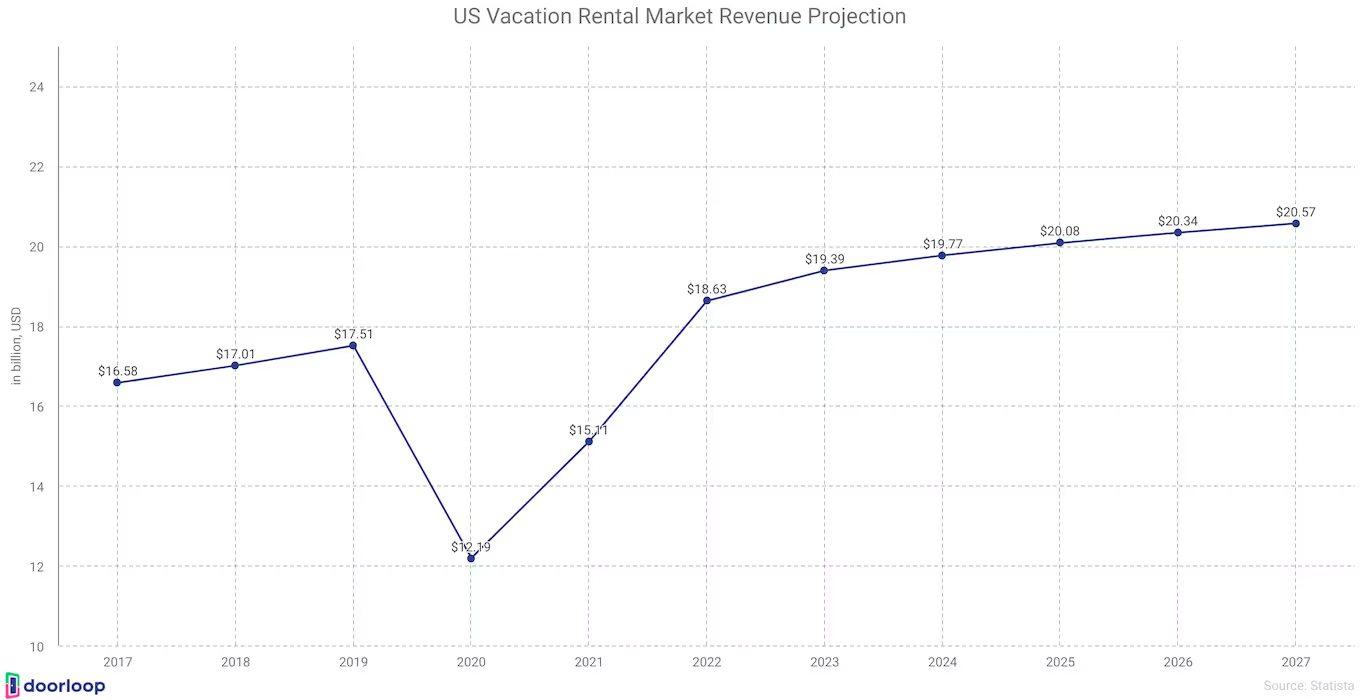
- It is expected that the annual revenue per unit in the vacation rental industry will be around US$1,550 in 2023.
- In 2022, it was reported that the average monthly revenue per listing in the United States was US$1,248.
- Millennials are the largest demographic group in the vacation rental market, spending an estimated US$180 billion on travel annually.
.avif)
- The age group of 25–34 years comprised the largest share of vacation rental renters in 2022, with 30.9% of the market. The age group of 35–44 years was the second largest, with 25.5% of the market.
- The projected user penetration rate (the percentage of people who are exposed to an ad and then take action, such as buying the advertised product or service) for 2023 is 18.3%. This is expected to rise to 18.1% in 2027.
- It is projected that, in 2023, the top five countries where user penetration will be high are Qatar, Spain, Estonia, France, and Italy.
- In 2022, business travel was projected to remain down by more than 20% for much of 2023, with only 58% of meetings and events taking place. The outlook still remains the same today.
- Business travel is projected to have a difficult time reaching at least 80% of 2019 travel levels in 2022–2023.
- In 2022, there were more than 2.9 million vacation rental hosts worldwide, with around 100,000 listings in 2021.
- It was forecasted that by 2023, there will be an average of 1,450,325 short-term rental listings in the US. In 2022, it was 1,260,091.
- In the same vein, there is a potential that these listings may perform worse as it is expected that there will be only 57.6% demand compared to 2022’s 59.5%. Unfortunately, it is showing signs of declining, having the 2021 demand around 59.5%.
- The resort/condominium segment is projected to have the highest CAGR of 5.4% from 2023 to 2030.
- Offline booking currently has the highest revenue share, but the online booking mode is projected to grow at a CAGR of 5.4%.
- Europe has the largest market share for vacation rentals, followed by Asia Pacific and North America. Australia is projected to have the highest CAGR of 6.6% from 2023 to 2030. China has the highest vacation rental industry revenue share in Asia.
Vacation Rental And Property Management Revenue Growth
While the vacation rental industry is expected to grow, it will be slow. Large property management companies are expected to grow the fastest, as they are more likely to have diversified revenue streams and are less affected by rising property prices.
Meanwhile, the number of short-term rental listings is also expected to continue to grow, as more properties are purchased for vacation rentals and more people become property managers.
- Large property management companies were expected to grow the fastest, with 82% projected to grow between 20% and 50%. This is due to their presence in traditional vacation rental markets. Larger companies were also more likely to report a significant income increase (20% or more).
- According to a survey conducted in October 2020, 55% of property managers already have diversified revenue channels. This acts as a safeguard, as most property managers nowadays strive to diversify their income streams. Meanwhile, 82% are interested in online travel agents (OTAs) like Expedia.
- Property managers will be able to expand more freely in 2023, as property prices are only expected to rise by 2.28%. This is significantly lower than the 14.3% rise in 2022 and the 16.8% rise in 2021.
- The number of short-term rental listings in Q3–Q4 2022 reached a peak of 1.3 million. This may indicate that more properties are being purchased for vacation rentals and more people are becoming property managers.
- However, the growth of the vacation rental industry is expected to slow down in 2023, with a projected growth rate of around 20%. This is a significant slowdown from the growth rates of around 120% in 2022 and 2021.
Vacation Rentals Occupancy And Rates
The occupancy rate for vacation rentals declined in 2020, but while hotels experienced a steeper decline, it is expected to bounce back faster. Meanwhile, many property managers are still struggling with all the changes that were brought upon by technology, the economy, and recent events.
- It was predicted that there might be a potential drop in occupancy rate by 56% in 2023. The pent-up demand during the pandemic years has caused the numbers to wildly go up from 2021 to 2022, and the numbers are now normalizing in 2023.
- In a partial data for the vacation rental performance in the US in 2023, vacation rentals had a 57.4% occupancy rate for the first five months of the year.
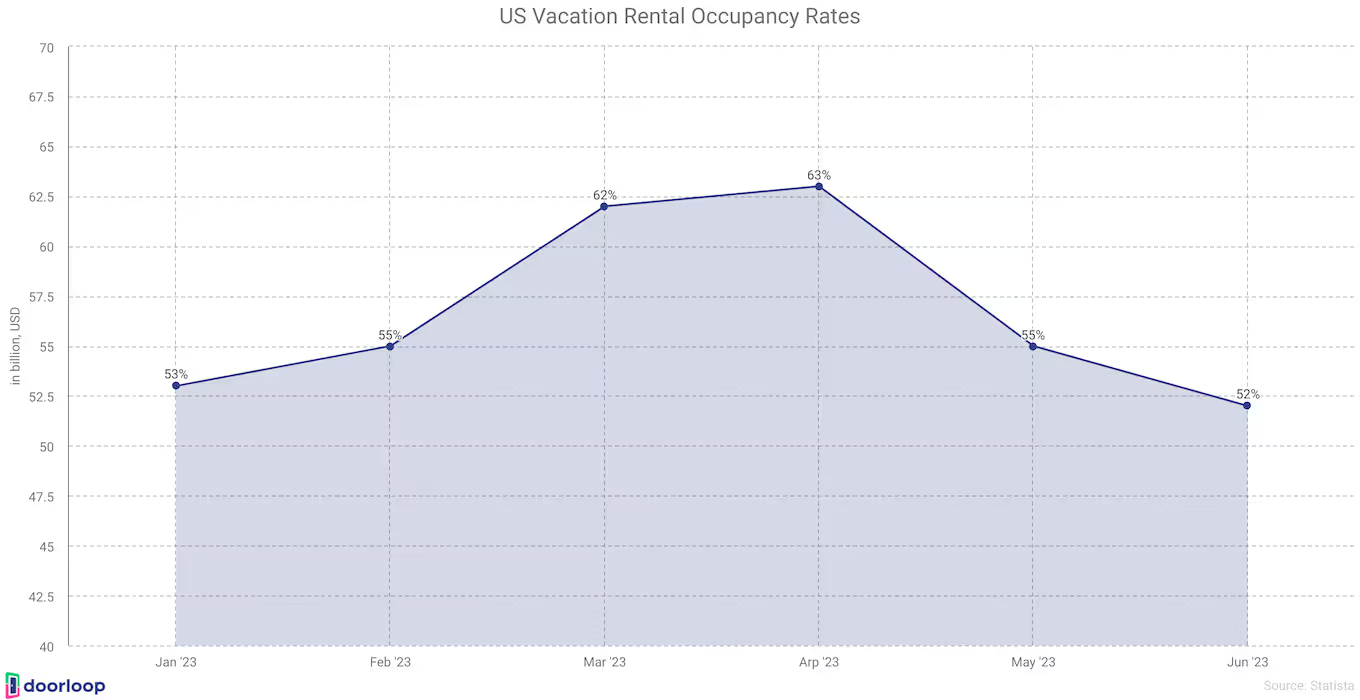
- The travel industry in the US is still booming, with short-term rental demand increasing by 130% in Q4 2023 compared to 2019. This is similar to the demand levels seen in Q1 2020 before the pandemic caused a significant dip to 65% in February–March 2020.
- However, vacation rentals in key tourist regions such as the Hawaiian Islands (62% occupancy rate), Southeast US (60%), and Southwest US (48%) are underperforming by -14%, -10%, and -10% respectively compared to 2022 data.
- The top three major concerns of hotel travel professionals in North America are labor supply (78%), labor costs (64%), and customer behavior and confidence (40%). A hospitality research company asked more than 200 hotel and travel professionals in North America this question: Which are the greatest challenges to your business recently? They were given the chance to choose five options.
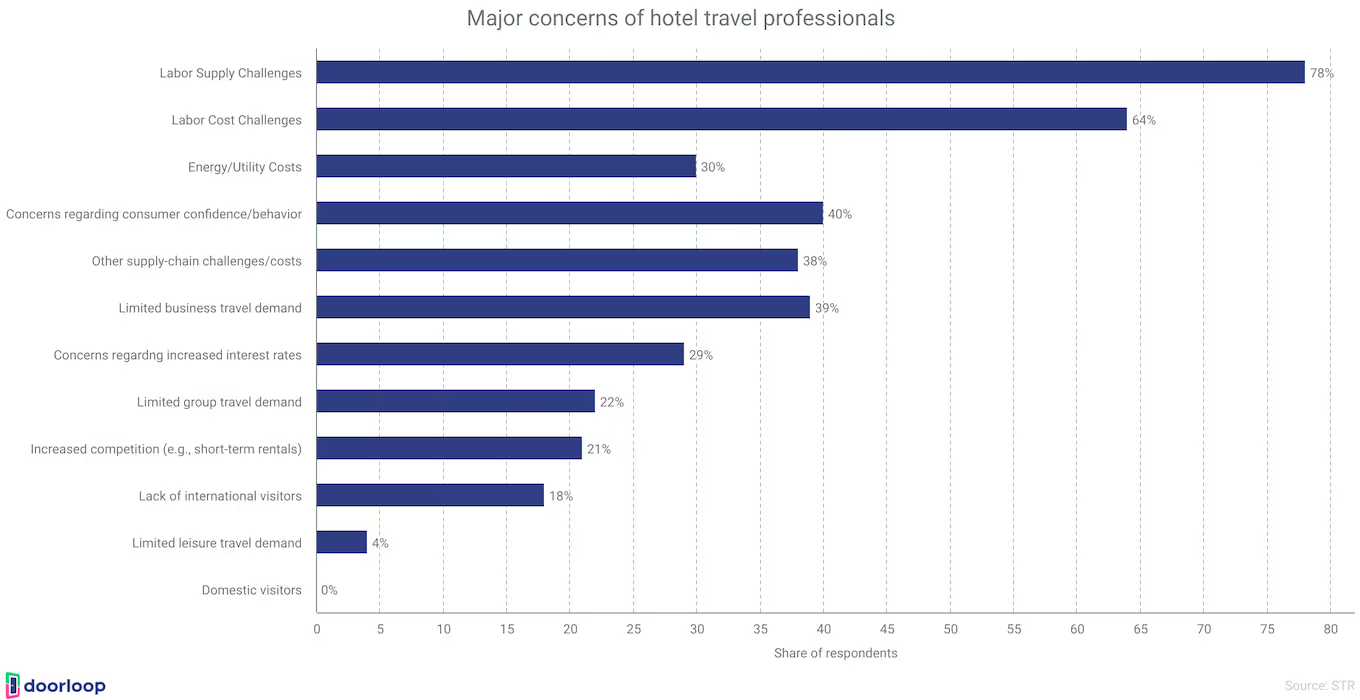
- In the same vein, the top three least of their concerns are domestic visitors (0%), limited leisure travel demand (4%), and lack of international visitors (18%).
- Meanwhile, another research found a different result and it was stated that 62% are challenged with operational efficiency while 54% cite revenue generation as their main challenge.
Vacation Rental Industry And Property Managers' Confidence In It
Most property managers are confident in the recovery of the vacation rental industry. Currently, they are trying to adapt to new technologies but some of them are unhappy with it. And the biggest pain point for property managers related to technology challenges is guest communications.
- According to a global rental report in 2022, a survey of 164 global property managers found that approximately 50% of them are confident in the industry's recovery. Meanwhile, nearly 29% indicate that demand is exceeding pre-pandemic levels.
- On the other hand, only 1% believed that the demand would never recover while 14% more believed that it would take some more years for it to reach its peaks in the previous years.
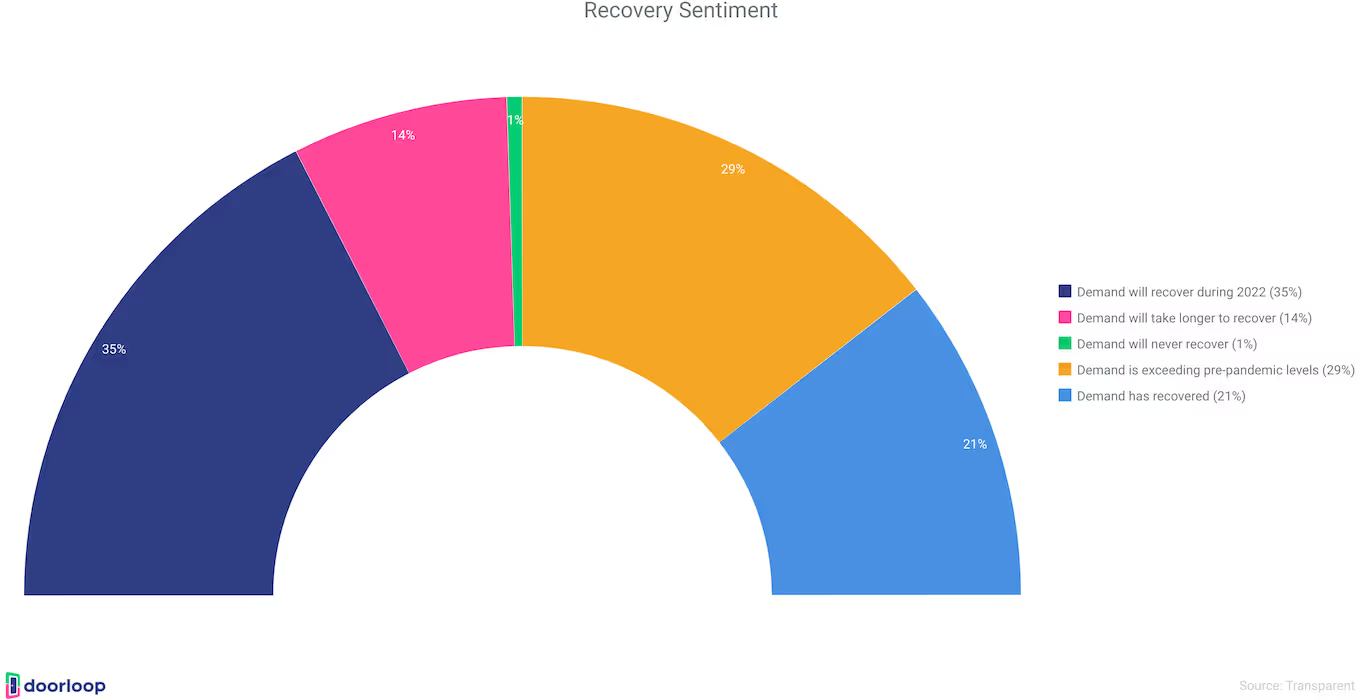
- Property managers expected 35% more bookings in 2022 compared to 2019 and it was much better in 2021. However, Asia and Latin America markets experienced a dip.
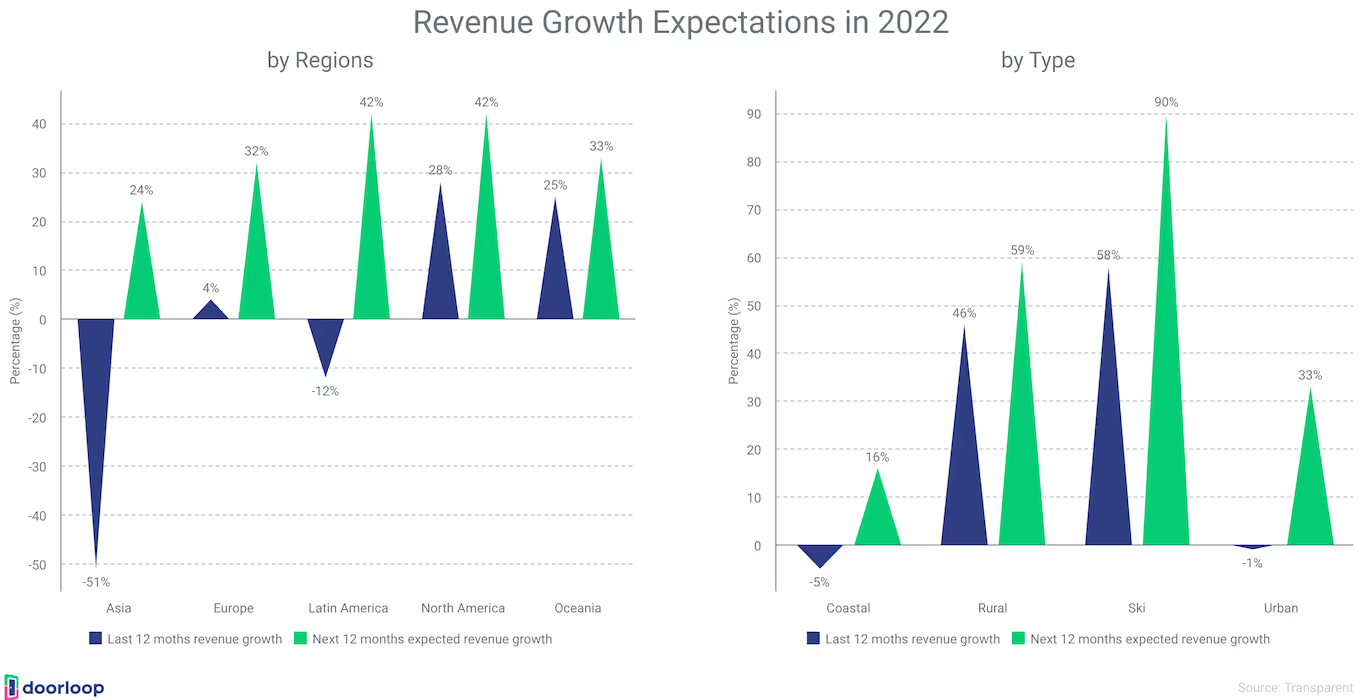
- Property managers expected 31% of bookings to be direct in 2022 as direct bookings are steadily increasing.
- Direct bookings did increase—in 2023, direct bookings are going strong with a 51% share in the total gross bookings, which amounted to US$96.1 billion. It was around 48% in 2021, and the gross booking totaled at US$72.2 billion that year.
- OTAs, meanwhile, are enjoying a 49% share of the market.
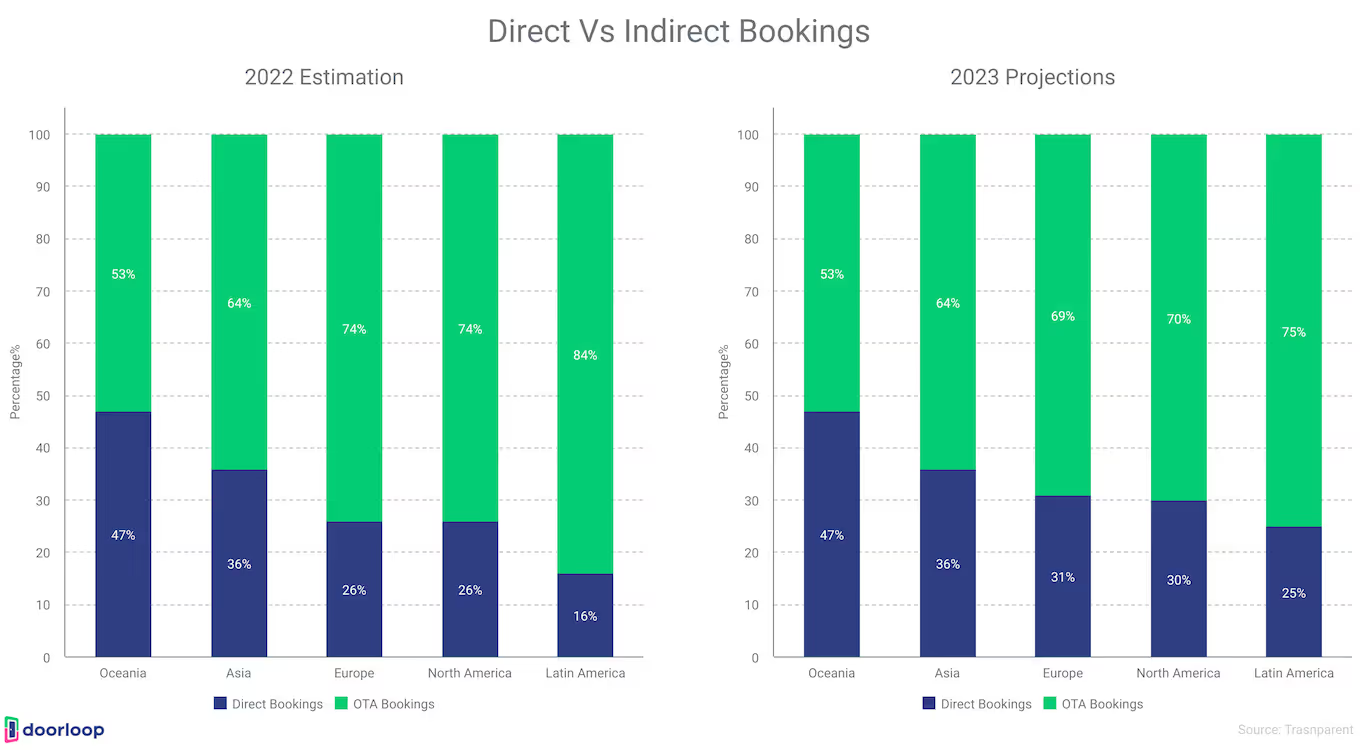
- When it comes to tech usage, channel managers are the most-used technology (74%) among property managers, followed by property management systems (73%). Moreover, 40% of property managers are using a data provider, a significant increase from 13% in 2019.
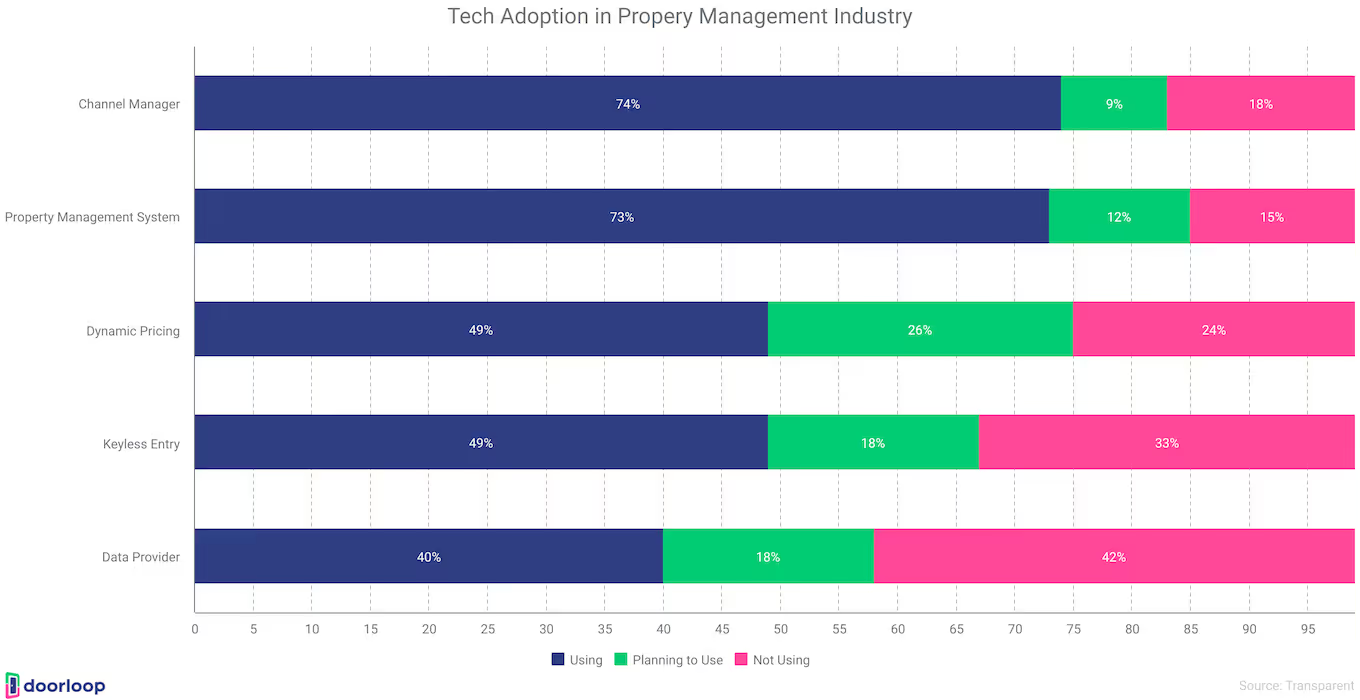
- However, 40% of property managers are unhappy with tech integrations. After all, some are still using legacy systems, and they are a bit resistant to change.
- Property managers are spending US$10,000 or more, which resulted in a 66% increase in booking revenue. This is because more property managers are into tech as there is a correlation between revenue growth and data investment.
- Thanks to tech, property managers often single-handedly deal with guest interaction (85%), distribution (73%), and key handling (68%) in-house. Meanwhile, Property managers in Asia provide the most services directly, while North American PMs are more likely to utilize partners.
- A survey conducted on property managers found that 21% of respondents identified guest communications as their biggest pain point related to technology challenges.
- Other challenges included guest vetting (17%), centralization (15%), and integrations (9%).
- Meanwhile, the number of nights booked in short-term vacation rentals is doing fairly well—its peak in 2022 was around 4.3 million during the months of March and April. However, this is comparatively lower than the year before, when it peaked at around 4.8 million.
Vacation Rental Demand
Vacation rental demand is shifting towards beach destinations, chalets, and pet-friendly homes. Families are also more likely to let their kids decide on their vacation destination, invite a friend, skip school, and disconnect from devices. Demand for 21–30 day stays has also increased, but travelers are tending to stay for shorter periods of time.
- Aside from that, respondents of a survey agreed that the beach (44.88%) is their top choice for their ideal vacation location. Locations near rivers and lakes came in second (31.5%), while mountains came in third (23.62%).
- In comparison, demand for coastal resorts was at 27%, and mountain and lake resorts combined were at (18%) in 2019. The rest prefer urban (21%), suburban (18%), small cities (10%), and mid-size cities (6%).
- The demand for urban reservations in Q3 2022 is 18%, which is still below the 27.5% demand in 2019. Suburban reservations demand in Q3 2022 is 11.6%, which is also below the 2019 demand of 17.9%. However, both demand trends are showing signs of recovery.
- Chalets are also seeing a surge in demand, with an 85% increase year-over-year with vacation rental demand surging in Ohio, New York, and Alaska in 2022.
- Another survey also found that families are changing their vacation rental preferences with 50% of families now letting their kids decide their vacation destination.
- Also, one in three families is more likely to let their kids invite a friend.
- Additionally, 53% of parents are more likely to let their kids skip school for vacation.
- Lastly, 61% of families are more likely to require their children to disconnect from devices on vacation.
- Demand for pet-friendly vacation homes is also increasing, with a 40% year-over-year increase. Over 70% of survey respondents are pet owners.
- Also, 44% of families are more likely to work remotely from a place that's not home.
- Demand for 21–30 day stays has also increased by 68%.
- However, recent data suggests that the average stay time is getting lower, with a projected length of stay for travelers in 2023 being 26.2 days. It is now down from 26.4 days in 2022.
- In addition, 77% of families have a greater appreciation for separating professional and personal life. Additionally, 84% have a greater appreciation for vacation time, and 91% have a greater appreciation for spending quality time with family.
Frequently Asked Questions
What is the size of the vacation rental market?
The global vacation rental market size in 2022 is US$82.63 billion.
What are the growth trends in the vacation rental market?
The vacation rental market is expected to grow at a CAGR of 4.7% from 2023 to 2030.
What are the preferences of families when it comes to vacation rentals?
According to a report, 50% of families now let their kids decide their vacation destination, and one in three families is more likely to let their kids invite a friend.
Meanwhile, 53% of parents are more likely to let their kids skip school for vacation, and 61% of families are more likely to require their children to disconnect from devices on vacation.
Which is more profitable for property managers: online or offline booking?
Offline booking mode currently has the highest revenue share, but the online booking mode is projected to grow at a CAGR of 5.4%. Currently, the majority of vacation rental sales (75%) were made online, while the remaining 25% were made offline.
What kind of guests do property managers should expect?
Millennials are the largest demographic group in the vacation rental market, spending an estimated US$180 billion on travel annually.
The age group of 25–34 years comprised the largest share of vacation rental renters in 2022, with 30.9% of the market. The age group of 35–44 years was the second largest, with 25.5% of the market.
Sources:
- grandviewresearch.com
- hostfully.com
- seetransparent.com
- airdna.co
- vrbo.com
- appfolio.com
- cdn2.hometogo.net
- str.com
- statista.com
- ahla.com
- businessofapps.com
- xola.com
- phocuswright.com
- keydatadashboard.com





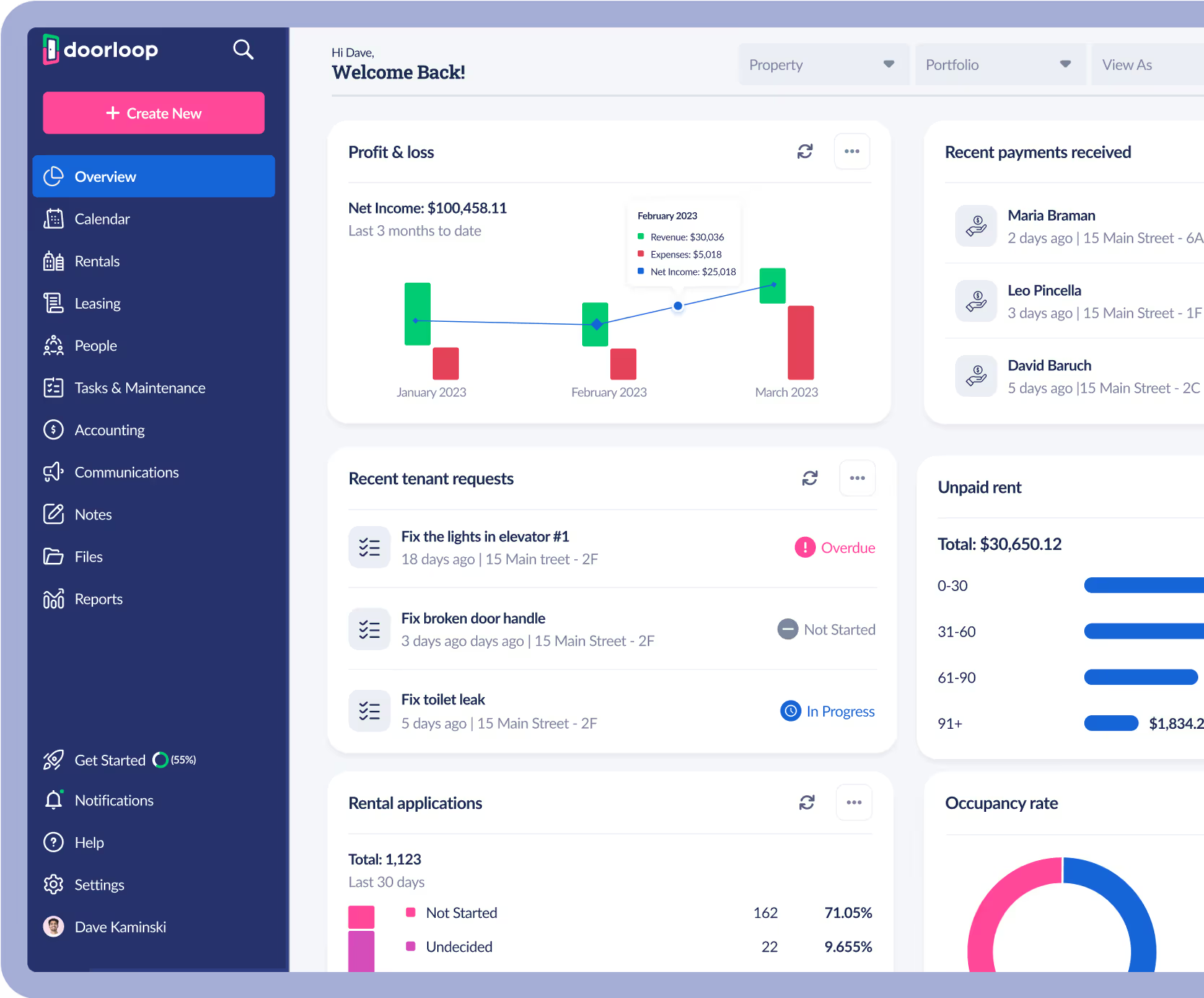


























.svg)
.svg)

